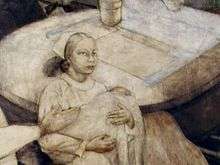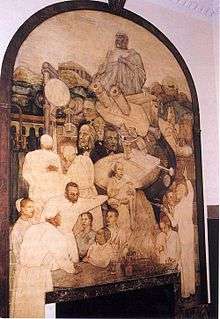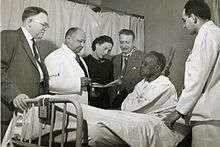Myra Adele Logan
Myra Adele Logan (1908–1977) was an American physician, surgeon and anatomist. She was the first woman to perform open heart surgery.[1]
Myra Adele Logan | |
|---|---|
.jpg) Myra Logan, at patient bedside, Harlem Hospital | |
| Born | 1908 Tuskegee, Alabama, US |
| Died | January 13, 1977 New York City, US |
| Education |
|
| Known for | first woman to perform open heart surgery |
| Medical career | |
| Profession | surgeon |
| Institutions |
|
Myra Adele Logan was born in Tuskegee, Alabama in 1908 to Warren and Adella Hunt Logan. She was the youngest of eight children. Her mother was college-educated and involved in the suffrage and health care movements. Her father was treasurer and trustee of Tuskegee Institute and the first staff member selected by Booker T. Washington. Logan's primary school education was conducted at Tuskegee's Laboratory, the Children's house. After graduating with honors from Tuskegee High School, she attended Atlanta University and graduated as valedictorian of her class in 1927. She then moved to New York and attended Columbia University, where she earned her M.S. degree in psychology. She worked for the YWCA in Connecticut before opting for a career in medicine.[1] Logan was the first person to receive a four-year $10,000 Walter Gray Crump Scholarship[2] that was exclusively for aiding African American medical students attend New York Medical College. She graduated in 1933.[3] She interned and did her residency in surgery at the Harlem Hospital in New York.[4][5]
Logan married painter Charles Alston on April 8, 1944.[3] They met while he was working on a mural project at the Harlem Hospital, where Logan was a medical intern at the time; Logan served as a model for Alston's Modern Medicine, in which she appears as a nurse holding a baby.[6]


Medical career
Logan became an associate surgeon at Harlem Hospital, where she spent the majority of her medical career. She was also a visiting surgeon at Sydenham Hospital and maintained a private practice. In 1943, she became the first woman to perform open heart surgery in the ninth operation of its kind.[4][7] She developed her specialty in children's heart surgery.[5] She also worked to develop antibiotics, including Aureomycin.[8] Logan and a team of physicians treated 25 lymphogranuloma venereum patients with Aureomycin and gained positive results.[9] Aureomycin was shown to reduce gland size of eight Buboes patients after four days of treatment.[10] She published her results in the Archives of Surgery and Journal of American Medical Surgery. Logan also published her results on Puromycin, tri-ethylene melamine in the A.M.A Archives of Internal Medicine and Acta-Unio Internationalis Contra Cancrum journals respectively. In 1951, Logan was elected a Fellow of the American College of Surgeons and was the first African American woman to become a member of this group.[5] During the 1960s, she researched the early detection and treatment of breast cancer. She developed X-ray processes that could more accurately detect differences in tissue density, allowing tumors to be discovered earlier. She was published in a number of medical journals and was one of the first black women to be elected to the American College of Surgeons.[3]

Logan was a founding partner and treasurer of the Upper Manhattan Medical Group of the Health Insurance Plan, one of the first group practices in the United States. She also worked with the NAACP's Health Committee, the New York State Fair Employment Practices Committee, the National Cancer Committee, the national medical association committee and Planned Parenthood.[3] She was a member of the New York State Commission on Discrimination during Governor Thomas E. Dewey's administration. In 1944 she resigned from the commission with seven other members after Dewey shelved anti-discrimination legislation they had drafted.[1][4]
Logan was also an accomplished classical pianist. She retired in 1970 and later served on the New York State Workmen's Compensation Board. She died of lung cancer at Mount Sinai Hospital on January 13, 1977.[3]
References
- Ogilvie, Marilyn; Harvey, Joy (2000). "Logan, Myra Adele (1908–1977)". The Biographical Dictionary of Women in Science. New York: Routledge. p. 800. ISBN 978-0-415-92040-7.
- College, New York Medical. "Walter Gray Crump". nymc.touro.edu. Retrieved 2019-05-02.
- Hine, Darlene Clark, ed. (1993). "Logan, Myra Adele (1908–1977)". Black Women in America: An Historical Encyclopedia (4th ed.). Brooklyn, N.Y.: Carlson Pub. ISBN 978-0-926019-61-4.
- "Dr. Myra Adele Logan". Journal of the National Medical Association. 69 (7): 527. 1977. PMC 2536929.
- Leonard., Bernstein (1996). Multicultural women of science : three centuries of contributions : with hands-on activities and exercises for the school year. Winkler, Alan., Zierdt-Warshaw, Linda. Maywood, NJ.: Peoples Pub. Group. ISBN 9781562567026. OCLC 34735963.
- "Harlem Hospital WPA Murals". Columbia University Institute for African-American Studies. Retrieved 29 January 2016.
- "Myra Adele Logan". HHS Office of Minority Health. Archived from the original on 15 June 2017. Retrieved 7 February 2015.
- Flint, Peter B. (January 15, 1977). "DR. MYRA LOGAN, 68; PHYSICIAN IN HARLEM". The New York Times.
- "New Potent Antibiotic". The Science News-Letter. 54 (5): 69. 1948. doi:10.2307/3925723. ISSN 0096-4018. JSTOR 3925723.
- "New Potent Antibiotic". The Science News-Letter. 54 (5): 69. 1948. doi:10.2307/3925723. ISSN 0096-4018. JSTOR 3925723.
Further reading
Haber, Louis (1979). Women pioneers of science. ISBN 978-0152992026. OCLC 731559034.